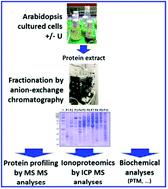当前位置:
X-MOL 学术
›
Metallomics
›
论文详情
Our official English website, www.x-mol.net, welcomes your
feedback! (Note: you will need to create a separate account there.)
Development of a metalloproteomic approach to analyse the response of Arabidopsis cells to uranium stress.
Metallomics ( IF 2.9 ) Pub Date : 2020-05-27 , DOI: 10.1039/d0mt00092b Manon C M Sarthou 1 , Benoît H Revel , Florent Villiers , Claude Alban , Titouan Bonnot , Océane Gigarel , Anne-Marie Boisson , Stéphane Ravanel , Jacques Bourguignon
Metallomics ( IF 2.9 ) Pub Date : 2020-05-27 , DOI: 10.1039/d0mt00092b Manon C M Sarthou 1 , Benoît H Revel , Florent Villiers , Claude Alban , Titouan Bonnot , Océane Gigarel , Anne-Marie Boisson , Stéphane Ravanel , Jacques Bourguignon
Affiliation

|
Uranium is a naturally occurring radionuclide that is absorbed by plants and interferes with many aspects of their physiology and development. In this study, we used an ionomic, metalloproteomic, and biochemical approach to gain insights into the impact of uranyl ions on the proteome of Arabidopsis thaliana cells. First, we showed that most of the U was trapped in the cell wall and only a small amount of the radionuclide was found in the cell-soluble fraction. Also, the homeostasis of several essential elements was significantly modified in the cells challenged with U. Second, the soluble proteome from Arabidopsis cells was fractionated into 10 subproteomes using anion-exchange chromatography. Proteomic analyses identified 3676 proteins in the different subproteomes and the metal-binding proteins were profiled using inductively coupled plasma mass spectrometry. Uranium was detected in several chromatographic fractions, indicating for the first time that several pools of Arabidopsis proteins are capable of binding the uranyl ion in vivo. Third, we showed that the pattern of some lysine and arginine methylated proteins was modified following exposure to U. We further identified that the ribosomal protein RPS10C was dimethylated at two arginine residues in response to uranyl ion stress. Together, these results provide the first clues for the impact of U on the Arabidopsis proteome and pave the way for the future identification of U-binding proteins.
中文翻译:

开发金属蛋白质组学方法来分析拟南芥细胞对铀胁迫的反应。
铀是一种天然存在的放射性核素,可被植物吸收并干扰植物生理和发育的许多方面。在这项研究中,我们使用离子组学、金属蛋白质组学和生化方法来深入了解铀酰离子对拟南芥蛋白质组的影响细胞。首先,我们发现大部分 U 被困在细胞壁中,并且在细胞可溶性部分中只发现了少量放射性核素。此外,在用 U 攻击的细胞中,几种基本元素的稳态显着改变。其次,来自拟南芥细胞的可溶性蛋白质组被分离成 10 个亚蛋白质组,使用阴离子交换色谱法。蛋白质组学分析鉴定了不同亚蛋白质组中的 3676 种蛋白质,并使用电感耦合等离子体质谱法对金属结合蛋白进行了分析。在几个色谱级分中检测到铀,首次表明几个拟南芥蛋白库能够在体内结合铀酰离子. 第三,我们发现一些赖氨酸和精氨酸甲基化蛋白的模式在暴露于 U 后发生了改变。我们进一步确定核糖体蛋白 RPS10C 在两个精氨酸残基处被二甲基化以响应铀酰离子压力。总之,这些结果为 U 对拟南芥蛋白质组的影响提供了第一条线索,并为未来 U 结合蛋白的鉴定铺平了道路。
更新日期:2020-05-27
中文翻译:

开发金属蛋白质组学方法来分析拟南芥细胞对铀胁迫的反应。
铀是一种天然存在的放射性核素,可被植物吸收并干扰植物生理和发育的许多方面。在这项研究中,我们使用离子组学、金属蛋白质组学和生化方法来深入了解铀酰离子对拟南芥蛋白质组的影响细胞。首先,我们发现大部分 U 被困在细胞壁中,并且在细胞可溶性部分中只发现了少量放射性核素。此外,在用 U 攻击的细胞中,几种基本元素的稳态显着改变。其次,来自拟南芥细胞的可溶性蛋白质组被分离成 10 个亚蛋白质组,使用阴离子交换色谱法。蛋白质组学分析鉴定了不同亚蛋白质组中的 3676 种蛋白质,并使用电感耦合等离子体质谱法对金属结合蛋白进行了分析。在几个色谱级分中检测到铀,首次表明几个拟南芥蛋白库能够在体内结合铀酰离子. 第三,我们发现一些赖氨酸和精氨酸甲基化蛋白的模式在暴露于 U 后发生了改变。我们进一步确定核糖体蛋白 RPS10C 在两个精氨酸残基处被二甲基化以响应铀酰离子压力。总之,这些结果为 U 对拟南芥蛋白质组的影响提供了第一条线索,并为未来 U 结合蛋白的鉴定铺平了道路。











































 京公网安备 11010802027423号
京公网安备 11010802027423号